From The CRPG Addict
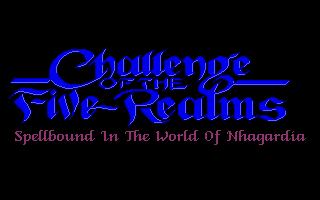 |
| If you count the subtitle, I think this is the longest title so far. |
Challenge of the Five Realms: Spellbound in the World of Nhagardia
United States
MicroProse (developer and publisher, under its Microplay label)
Released 1992 for DOS
Date Started: 2 November 2019
I’ve been looking forward to Challenge of the Five Realms for a couple of years. The team behind it, working at Paragon Software, had been responsible for the 1990-1991 spate of licensed Games Designers’ Workshop (GDW) disasters, including the two MegaTraveller games, Space 1889, and Twilight: 2000. Each of the games had its qualities, but in general, the sense was that Paragon had taken on too much too fast. The games’ poor reviews and sales led to the collapse of Paragon and its purchase by MicroProse in 1992. Now, the team, working for more competent managers, was free to develop a game without any GDW restrictions. Would it be better or worse? I’ve been anxious to find out.
It takes a while to get into
Challenge. It begins with a long, unintentionally hilarious, animated
opening sequence with fully-voiced dialogue, the second 1992 game to do so (after
Ultima Underworld). It accompanies a long backstory in the game manual. The two don’t fully gibe with each other, but I’ll do my best to summarize below. First, we get a female voice on a black screen welcoming us to the kingdom of Alonia, one of the titular five realms, “where folklore and myth are a way of life.”
 |
| I know this isn’t the only flat world we’re going to see this year. |
We have a brief glimpse of Nhagardia, a flat, oval world. Because it’s flat and does not rotate, the parts that support life have always known eternal sun. This revelation sent me off on a bit of Googling. I have a basic understanding of why planets are naturally spheres due to the way their formed by aggregating rotating collections of matter. I also understand how gravity favors orbs and thus works over time to turn any shape into a roughly-spherical one. What I wondered–and still wonder, since I couldn’t find enough discuss on the topic to satisfy me–was whether the slow process of gravity pulling a large amalgamation of matter into a sphere necessarily outpaced the same processes that give the same body an atmosphere and the conditions necessary for life. That is, if some weird freak of accident did result in a flat-ish “planet” (I realize the definition of “planet” presupposes a sphere, but you know what I mean) in stable orbit around a sun, would it be possible for such an object to trap an atmosphere and create complex life before the natural tendencies of gravity made a sphere out of it? How would gravity even work on such an object? Could an atmosphere truly exist?
Discussion welcome, but back to the game. We move from planet level to Castle Ballytogue, which must be based on Ballyutogue from Leon Uris’s
Trinity. It is the year 1000 “A.S.” The pompous King Clesodor is haranguing his advisors for not allocating enough funds to the New Year’s celebration. “I want this to be the greatest celebration in Alonia’s history,” he demands. The manual doesn’t have any credits for the voice actors, but I’d swear that Clesodor is voiced by Maurice LaMarche, testing out a precursor to “The Brain” voice that he’d bring to
Animaniacs the following year.
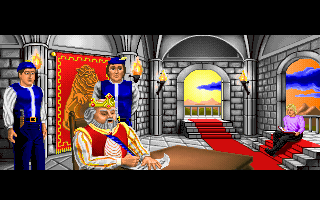 |
| Clesodor meets with his advisors. |
Clesodor takes some time out from his party planning to yell at his son, the Prince, for idly reading a book. “I swear, the boy is just like his mother. Witches and seers and myths. What kind of king will you make if all you care about are mindless stories? A king is a ruler, not a dreamer!” The first bit about the mother is all the more harsh if you’ve read the backstory and learned that Clesodor’s wife, Queen Feya, is in fact dead, killed in a tragic accident at “the cliffs of Mahor.”
(I had to take a break from the game at this point to call Patrick, the British friend that
I’ve talked about before. Back in 2007, we were traveling along the west coast of Ireland. He happened to mention that the last time he was there, a few years prior, he’d heard on the news that a British tourist had been killed while falling from the Cliffs of Moher. The same night, we got into Galway, checked into a hotel, turned on the TV, and immediately caught the opening headline from the local newswoman: “Tragedy in County Clare today as a young man fell to his death from the Cliffs of Moher.” Ever since then, we have this ongoing joke that every Irish television news broadcast begins with a report of yet another death at the Cliffs of Moher. Maybe you had to be there.)
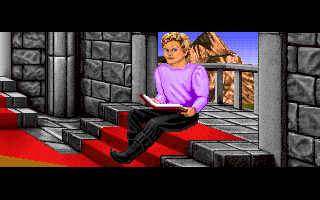 |
| The idle prince idles. |
The perspective now shifts to the Prince, a complete milquetoast, who is reading a picture book that should be far below his age. It’s called The Legend of Nhagardia. Recently, the Prince, worried for his father’s health, had followed from the castle a mysterious stranger who had met with his father in private. The stranger turned out to be an ex-sorcerer named Shiliko who had been summoned to help stop the king’s recurring nightmares. Unable to do anything, Shiliko had cast a placebo spell. When confronted by the Prince, Shiliko gave the boy the book.
The book tells the story of an ancient emperor named Shamar who, seeing that the end of his life was near, set off on a quest to extend it. Before disappearing, he divided his crown and power among his five territories. Alonia, the terrestrial realm, was given to King Adama. The elf Sandro took over Fraywood, the forest realm. Oberus ascended to rule the skies in Aerius. Lorelei, the (curiously male) king of Thalassy, took over the ocean. And inside the depths of the world, the gnome Kyke became the ruler of Alveola. Over time, the portals between realms closed and the rulers lost contact with each other. Clesodor is presumably a descendant of Adama.
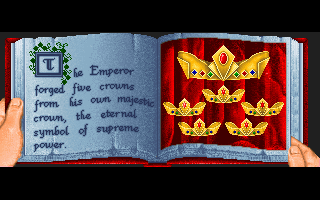 |
| The original must have been huge. |
Suddenly, there’s a disturbance by the window and a fearsome apparition appears. The cloaked, scaly, black-skinned creature introduces himself as Grimnoth. “Though I come to you now as a mere apparition, heed my warning,” he says. “I will return to your world on New Year’s Day and claim power over your kingdom. You will surrender your crown to me on that day.” He continues by warning Clesodor that even in his “astral form,” he can destroy him.
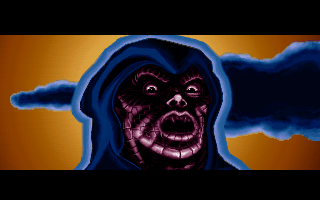 |
| The kingdom is menaced by Xusia. |
Clesodor of course mouths off to Grimnoth, so Grimnoth extends his hand and vaporizes Clesodor and his advisors with a ray of light.
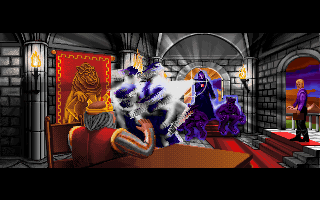 |
| Grimnoth’s spell destroys two courtesans before it reaches the king. |
“Nooooooooooooo,” the Prince shouts.
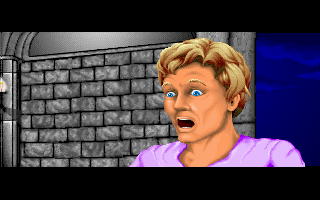 |
| “Do not want!” |
Addressing the Prince, Grimnoth says that he’s put a plague of darkness on the world, and if the Prince brings the crown to him at Castle Thiris on New Year’s Day, he’ll lift the darkness. This seems a little unfair. Before he killed Clesodor, Grimnoth was prepared to return to the castle to collect the crown. Now he’s making the Prince trek hundreds of miles to bring it to him. Thiris is in the center of the world, the seat of the former Emperor Shamar, now abandoned and monster-ridden.
The Prince vows to avenge his father and begins by ransacking his mother’s belongings, finding among them a reference to a witch named Cagliostra, who Clesodor had banished. “Father, I know you thought I was a dreamer, but I’ll avenge your death. I’ll make you proud!” the Prince declares, just before a hand appears from off-screen, and someone clocks the Prince over the head with a mace, knocking him unconscious.
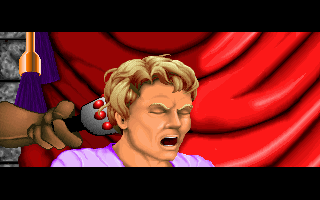 |
| This just isn’t his day. |
Paragon’s titles had all featured a
MegaTraveller-inspired character creation process by which each character went through a career in a military branch or profession (or both) which shaped his or her skills and abilities. Since the protagonist of
Challenge–the Prince–has more of a fixed background, I didn’t expect the character creation process to be quite the same. It isn’t. Instead, the game feeds you a number of situational questions and asks how you’d react to them.
 |
| One of many, many questions in character generation. |
This is often described as
Ultima IV-style character creation, but it’s not.
Ultima IV‘s scenarios were about pitting one virtue against another to help determine what virtue primarily guided your moral compass.
Challenge‘s questions are more about pitting various skills and abilities against each other, ultimately determining if you’re more of a fighter, mage, diplomat, or thief–or a balance among them. I lost track of how many questions the game asks–I think it is in the ballpark of one hundred thousand–but it later struck me that the “quick” option, which just rolls random numbers for your attributes and abilities, performs just as well.
There aren’t that many skills, making me hope that unlike the GDW games, this one actually uses all of them. “Stealth,” “Crime,” and “Fly” were all set to 0 when I started (the lowest score I got was otherwise 20), so perhaps it doesn’t use those.
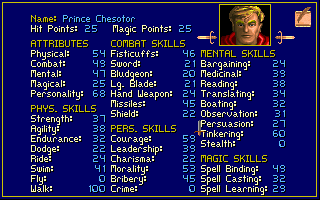 |
| The game’s attributes and skills. The Prince takes a level in badass in his portrait. |
The game finally begins when the Prince wakes up in his mother’s bedchamber, head throbbing, bereft of equipment or supplies, including the crown that he’s supposed to bring to Grimnoth. He soon runs into Hastings, the dead king’s seneschal, in the next room. Hastings explains that when the king was killed, his knights looted the castle and fled with its riches to Duke Gormond of Vinazia, who despises me. Rumors are already spreading that the Prince killed his father. Hastings recommends that I forget about Cagliostra, but if I’m determined to seek her out, her old friend Sir Oldcastle hangs around the Boar’s Head Tavern. Hastings stays to guard the castle after giving the Prince a key to a chest.
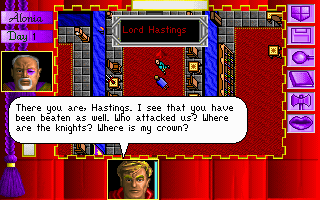 |
| Encountering my first NPC. |
Challenge‘s interface is axonometric with continuous movement and real-time events. A row of icons offers party options, disk options, navigation options, spell options, combat options, and speech options. Of the developers’ previous titles, it most recalls Space 1889, but with some elements tossed in from other games. For instance, if you’re trying to speak to a moving NPC, you can use the “Hail” option to get him to stop; this is from MegaTraveller 2. Most commands have redundant keyboard backups except (annoyingly) movement, which has to be done with the mouse. One key I’m using a lot is (P)ause, every time I stop to blog or something, because commenters have warned me that the game has a time limit. “Ridiculously short” is how one described it.
I naturally started exploring the castle. As Hastings said, most of the court had fled. Sir Feldoth and Sir Elault still guarded the ramparts. Imrid the Manservant was wandering the lower halls and begged me to just give Gormond the crown. A couple more servants, Horric and Horville, were in the basement. Horric told me that a thief carried of a chest with the queen’s insignia on the lid. Dialogue so far has been entirely scripted, with the Prince (or I guess, King) responding to questions on his own.
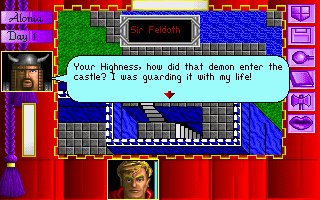 |
| “I do not know, but you will die for your failure!” is an option a really good RPG would have given me. |
Finally, in one room, I found a broadsword, axe, long bow, rapier, and arrows. You basically have to hover your mouse over all objects that you think you might be able to pick up. As far as I can tell, chests and wardrobes and such are just decorations, as there is no command to open them and (F)ind never seems to do anything.
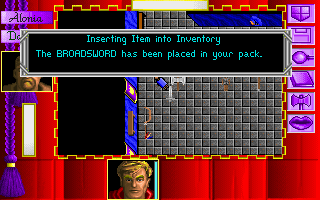 |
| Finding some weapons at last. |
In the kitchens, Wilagon Blacklost gave me the Holy Book of Equus, which has a spell called “Truth.” I tried to learn it, but the game told me that I wasted half a day and failed. I tried again, and it told me that I destroyed the book. I reloaded and figured I’d save that for later. The kitchens also had a variety of spell components and food.
Outside the castle, some flowers and other objects joined my list of spell components. A rough character at the end of the drawbridge offered to give me a hint for 100 gold pieces. Since I started with 1,000, I paid him. He said that there are a couple of loudmouths at the local tavern who claim to have stolen the queen’s treasure chest.
I continued exploring the castle outskirts. In one shop, a man offered to sell me spells for small fees. Almost every one I chose required components that neither he nor I had, except for “Warding Spell,” “Open Lock,” “Lightning Bolt,” “Inner Noise,” and “Slow.” Paying the man didn’t actually get me the spells–just books that give me a chance of learning them.
 |
| Some of the spell shop selections. |
Elsewhere, I found a healer, a pawn shop, a weapon shop, a food store, an armor shop, and a tavern. At the tavern, I bought some chainmail and equipped it. The inventory system seems needlessly complex. From your character screen, you can go to “inventory” (which never seems to have anything) and separate buttons for your pouch inventory, your backpack inventory, and your chest inventory (you start with no chest). But you can also go to “garb,” a screen with a paperdoll of the character, which also has links to inventory, pouch inventory, backpack inventory, and chest inventory. Spell components seem to show up in none of those places.
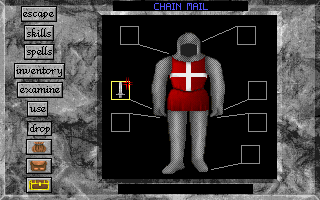 |
| Part of the confusing inventory system. |
In the tavern, I met Sir John Oldcastle and several of his friends. Oldcastle had been a skilled swordsman, but he was banished by King Clesodor for drunkenness. He is clearly based on Shakespeare’s Falstaff, although a bit more competent. I tried to enlist him into my cause, but he mocked me by calling me “Miss P.” and said that he doubted I’d be able to stand up to Duke Gormond. He agreed to join me and help me find Cagliostra if I would bring him the Widow Frazetti’s fabled jeweled brooch.
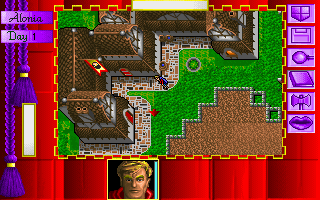 |
| The tavern from the outside is a nice looking building. |
As I explored, it became clear that several houses had been looted in the chaos following the king’s death, including Frazetti’s. I ultimately tracked down the bandits, the Hammerhand brothers, to a bar in the western part of the map. They were drunk, which made the subsequent combat a little easier.
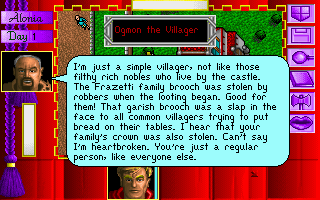 |
| An NPC shows a shocking lack of respect for the king and his neighbors. |
Combat appears to take place in several phases and draws heavily from the MegaTraveller system. In the first phase you place your party members on the combat map, which is the same as the regular map without the surrounding command interface. Once combat begins, you issue orders for each character–target a particular enemy, cast a spell, defend an area, or move–and then unpause the game. Characters act on their own until you pause again and issue new orders.
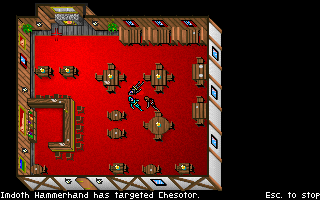 |
| The game has me fight the second Hammerhand brother as the first lies dead above me. |
In short order, I killed the brothers and looted their bodies for my mother’s chest, the Frazetti brooch, and a bracelet that they pillaged from another NPC. I returned the brooch to Oldcastle, who joined me, but it occurred to me that I should have tried returning it to the Frazettis first.
I also found the house of the wizard Shiliko. He had hung himself. A note nearby indicated that he blamed himself for the appearance of Grimnoth and all the chaos that followed, but it didn’t explain his reasoning.
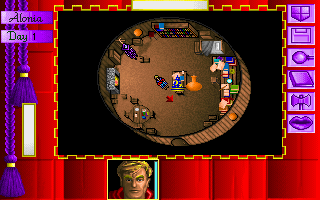 |
| Shiliko’s hut, with Shiliko hanging in the upper-left. |
At this point, I think I’ve exhausted exploring the castle. Judging by the world map, there are a couple of other cities in Alonia to visit, and then the other realms. Oldcastle said that we’d find clues for Cagliostra in the city of Farinor, so I suppose that’s where I’ll go next.
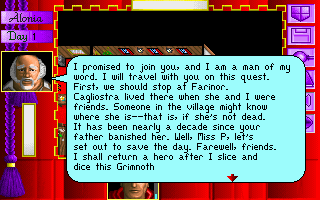 |
| Oldcastle insultingly joins the party. |
It’s been a relatively promising start. Although aspects of the animated sequence were a little goofy, the backstory is strong. The interface is a little clunky but not overly so. I like that we’re already seeing side-quests–one of the few things that Paragon did well in its previous titles. Dialogue is verbose enough to actually give characterizations to the NPCs, but I wish there were more options from the PC’s side. Overall, I look forward to my next session and seeing how the game develops.
Time so far: 3 hours
Original URL: http://crpgaddict.blogspot.com/2019/11/game-345-challenge-of-five-realms.html





















